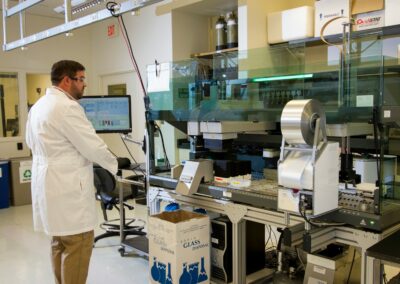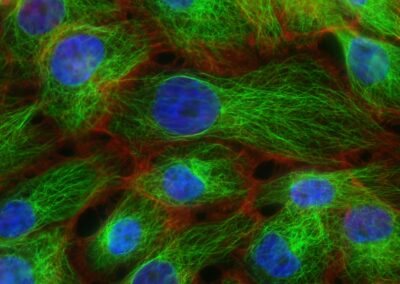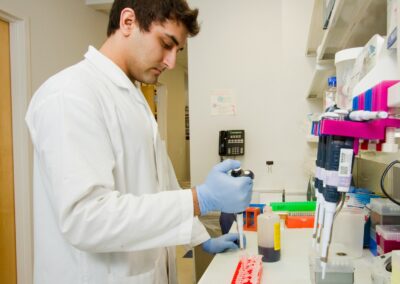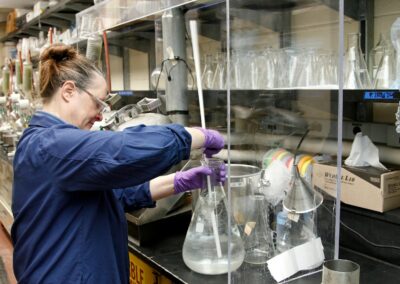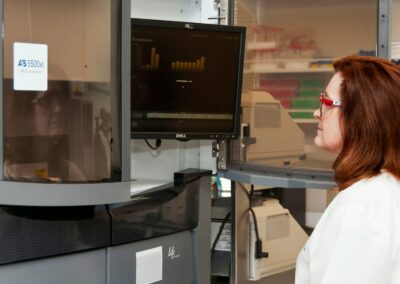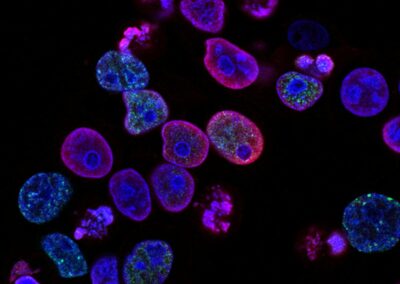Addressing Technical and Practical Obstacles in DNA-Based Computation
Technical Challenges in DNA-Based Computation
The development and implementation of DNA-based computation systems face numerous technical challenges that must be addressed to realize their full potential. One of the primary challenges in DNA-based computation development is ensuring the accuracy and reliability of computations. DNA molecules are inherently prone to errors during synthesis and manipulation, which can lead to incorrect results. This issue is exacerbated by the complexity of biochemical reactions involved in DNA computing, requiring sophisticated error-correction mechanisms to ensure reliable outcomes.
Another significant technical challenge is the scalability of DNA-based computation systems. While DNA computing offers the promise of massive parallelism, scaling these systems to handle large-scale computations is complex. The sheer volume of DNA required for extensive computations presents logistical and technical hurdles, such as the need for precise control over biochemical environments and efficient methods for reading and writing DNA sequences. These challenges necessitate advancements in biotechnology and nanotechnology to create scalable and practical DNA-based computing platforms.
Moreover, the speed of DNA-based computations poses a challenge. Although DNA computing can perform many operations in parallel, the actual time taken for biochemical reactions can be slow compared to electronic computations. This limitation affects the real-time applicability of DNA-based systems in industries that require rapid data processing. To overcome this, researchers are exploring hybrid approaches that combine the strengths of DNA and electronic computing to achieve faster and more efficient computational performance.
Practical Implementation Challenges
Beyond technical hurdles, the practical implementation of DNA-based computation systems presents its own set of challenges. One major obstacle is the high cost of synthesizing and manipulating DNA. The processes involved in creating and manipulating DNA sequences are currently expensive, making large-scale adoption of DNA-based computing economically unfeasible. To address this, ongoing research aims to develop cost-effective methods for DNA synthesis and sequencing, potentially lowering the barriers to widespread implementation.
Integration with existing technological infrastructures also poses a challenge. DNA-based computation systems need to be compatible with current digital technologies to facilitate seamless integration into existing workflows. This requires the development of interfaces and protocols that enable efficient communication between DNA-based systems and traditional electronic systems. The complexity of creating such hybrid systems necessitates collaboration between biotechnologists, computer scientists, and engineers to develop practical solutions.
In regions like Saudi Arabia and the UAE, where technological innovation is a priority, addressing these practical challenges is crucial for the successful adoption of DNA-based computation. By investing in research and development, fostering public-private partnerships, and creating supportive regulatory environments, these nations can lead the way in overcoming the practical obstacles to DNA-based computation. Such efforts will pave the way for the integration of this cutting-edge technology into various industries, driving economic growth and technological advancement.
Leadership and Management in Navigating DNA-Based Computation Challenges
Effective leadership and management are essential in navigating the challenges associated with the development and implementation of DNA-based computation systems. Leaders in Saudi Arabia and the UAE must be equipped with the knowledge and expertise to guide their organizations through the complexities of adopting this advanced technology. This involves fostering a culture of innovation and continuous learning within the organization, ensuring that teams are prepared to tackle the technical and practical challenges of DNA-based computation.
One key aspect of leadership in this context is strategic planning. Leaders must develop comprehensive strategies that outline the steps necessary to implement DNA-based computation systems, including investments in research and development, collaborations with academic and industry partners, and the establishment of robust infrastructure. By setting clear goals and milestones, leaders can effectively manage the transition to DNA-based computation and ensure that their organizations remain at the forefront of technological innovation.
Additionally, effective communication and collaboration are critical in overcoming the challenges of DNA-based computation. Leaders must articulate the potential benefits and challenges of this technology to stakeholders, including employees, investors, and customers. By fostering a collaborative environment, leaders can ensure that all members of the organization are aligned with the strategic vision and working towards common goals. This approach will be instrumental in driving the successful adoption of DNA-based computation and achieving long-term business success.
Strategic Implications of DNA-Based Computation for the Middle East
Saudi Arabia and UAE: Leading the Charge in Technological Innovation
Saudi Arabia and the UAE are uniquely positioned to become global leaders in technological innovation, with DNA-based computation playing a central role in this transformation. These nations have made significant investments in advanced technologies and are committed to fostering environments conducive to innovation. By addressing the challenges associated with DNA-based computation, Saudi Arabia and the UAE can enhance their technological capabilities and drive economic growth.
In Riyadh, initiatives such as the National Transformation Program and Vision 2030 highlight the country’s commitment to technological advancement and economic diversification. Overcoming the challenges of DNA-based computation aligns perfectly with these goals, offering a pathway to developing new industries and creating high-tech jobs. By integrating DNA-based computation into their technological ecosystems, Riyadh can attract global talent and investment, solidifying its position as a hub of innovation.
Similarly, Dubai’s futuristic vision and ambitious projects make it an ideal candidate for the adoption of DNA-based computation. The Dubai Future Foundation and other forward-thinking organizations are already exploring the potential of DNA-based computation and other advanced technologies. By leveraging the unique capabilities of DNA-based computation, Dubai can enhance its smart city initiatives and drive economic growth, positioning itself as a global leader in technological innovation.
Integrating DNA-Based Computation with AI and Blockchain
The intersection of DNA-based computation with artificial intelligence (AI) and blockchain presents exciting possibilities for technological advancement and business innovation. These technologies, when combined, can create powerful synergies that drive unprecedented levels of efficiency, security, and functionality. For businesses in Saudi Arabia and the UAE, this convergence offers a unique opportunity to stay ahead of the curve and maintain a competitive edge in the global market.
AI can significantly enhance the capabilities of DNA-based computation by providing advanced algorithms and machine learning techniques to optimize computational processes. This integration can lead to more intelligent and adaptive systems, capable of handling complex tasks with greater precision and speed. For example, AI-powered DNA-based computation can be used in predictive analytics, enabling businesses to make data-driven decisions and anticipate market trends more accurately.
Blockchain technology, known for its robust security features, can complement DNA-based computation by providing secure and transparent frameworks for data transactions. This combination can be particularly beneficial in sectors such as finance and healthcare, where data integrity and security are paramount. By leveraging blockchain-enabled DNA-based computation, businesses can ensure the reliability and confidentiality of their data, fostering trust and confidence among stakeholders.
Embracing the Metaverse and Generative AI
The Metaverse and generative artificial intelligence (AI) are two emerging trends that hold immense potential when integrated with DNA-based computation. The Metaverse, a virtual universe that combines augmented reality (AR), virtual reality (VR), and the internet, offers new opportunities for immersive experiences and digital interactions. By incorporating DNA-based computation, the Metaverse can achieve greater computational power and efficiency, enhancing the realism and interactivity of virtual environments.
In Saudi Arabia and the UAE, the adoption of the Metaverse can drive innovation in various sectors, including entertainment, education, and retail. For instance, businesses can create virtual storefronts and immersive shopping experiences, offering customers a new way to interact with products and services. Educational institutions can leverage the Metaverse to provide interactive and engaging learning experiences, while the entertainment industry can explore new avenues for content creation and distribution.
Generative AI, which involves using AI to generate new content and ideas, can also benefit from the integration of DNA-based computation. This combination can lead to more sophisticated generative models, capable of producing high-quality content in real time. For businesses, this means the ability to create personalized marketing campaigns, develop innovative products, and streamline content creation processes. The synergy between DNA-based computation, the Metaverse, and generative AI represents a new frontier in technological innovation, with vast potential for business growth and success in Saudi Arabia and the UAE.
Conclusion
In conclusion, the development and implementation of DNA-based computation systems face several technical and practical challenges. For businesses in Saudi Arabia and the UAE, addressing these challenges is crucial for harnessing the full potential of this advanced technology. By investing in research and development, fostering collaboration, and implementing effective leadership strategies, these nations can overcome the obstacles associated with DNA-based computation and drive economic growth. Integrating DNA-based computation with other emerging technologies, such as artificial intelligence, blockchain, the Metaverse, and generative AI, will position Saudi Arabia and the UAE as global leaders in technological innovation and business success.
#DNABasedComputation #TechnologicalChallenges #Innovation #SaudiArabia #UAE #ArtificialIntelligence #Blockchain #Metaverse #GenerativeAI #Riyadh #Dubai #BusinessSuccess #LeadershipSkills #ProjectManagement






